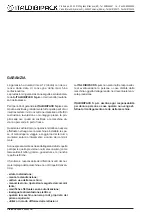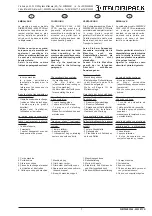
Via Europa, 35 - 20010 Pogliano Milanese (MI) - Tel. 02/9396461 r.a. - Fax 02/93549494
Via del Mare 32/A (interno D) - 00040 Pomezia (Roma) - Tel. 06/9100417 - Fax 06/9100430
DIBIPACK 3246 - 4255 STCN
F
GB
D
E
11
DESCRIPTION ET
CARACTERISTIQUES
TECHNIQUES
Machines à conditionner
DIBIPACK 3246 - 4255 STCN
Machine pour conditionnements
produit avec film plastique
monopli thermosoudable, dans
les limites dimensionnelles
indiquées aux paragraphes
suivants, avec soudure angulaire
du film ou soudure-coupe et
thermorétraction simultanée.
Chaque fois que l’opérateur
abaisse la cloche transparente la
chaleur d’un fil soudant et la
pression de ce dernier avec un
repoussoir inférieur sur le corps
machine, revêtu de téflon,
déterminent la fusion du film et la
séparation des bords produisant
ainsi la confection.
ON NE PEUT PAS
CONDITIONNER :
- des produits granulés en
vrac;
- des produits mouillés;
- des produits liquides et/ou
gélatineux à moins qu’ils ne
soient contenus dans une
autre confection;
- des produits hautement
inflammables;
- des produits explosifs;
- des bombes contenant du gaz
sous pression, etc…
- et tout ce qui pourait
endommager la machine o
être dangereux pour la santé
de l’opérateur; (par exemple
acides, agents corrosifs, sel).
En cas d’utilisation avec des
produits alimentaires il est
recommandé d’utiliser des films
plastiques thermosoudables
aptes au contact avec les
aliments.
Il est rappelé dans tous les cas
que la machine n’est pas
appropriée à être mise en contact
avec des aliments.
PLAQUES (Signalisations de
danger et Marquage CE)
Les machines sont produites en
conformité avec la Directive
Communautaire 98/37 CEE
dénommée Directive Machines,
la Directive Basse tension (DBT)
73/23 CEE et amendements
successifs et la Directive
Compatibilité Electromagnétique
(EMC) 89/336 CEE et amen-
dements successifs.
Toutes les pièces qui composent
la machine sont adéquates aux
requêtes des Directives et le
marquage CE en témoigne la
conformité.
Lisibilité et conservation des
plaques
Dans le cas où une plaque soit
détériorée et/ou qu’elle ne soit
plus lisible, même si cela ne
concerne qu’un seul des
éléments d’information reportés,
en demander une autre au
constructeur et pourvoir
obligatoirement à sa substitution.
DESCRIPTION AND
TECHNICAL
CHARACTERISTICS
DIBIPACK 3246 - 4255 STCN
Wrapping machines
Machine for the packaging of
products with single-fold sealing
film, with dimensions contained in
the range indicated in the
following paragraphs, with
angular sealing of the film and
featuring simultaneous cutting or
sealing-cutting and shrink-
wrapping.
Each time that the operator
lowers the transparent hood the
heat of the sealing wire and its
pressure against the bottom
Teflon-coated edge on the
machine body cause the film to
melt and the edges to separate,
thus creating the packaging.
The shrinking of the film can be
carried out at the same time as
the cutting and is achieved by the
circulation of hot air forced around
the package.
THE FOLLOWING ITEMS MUST
NOT BE PACKAGED:
- loose granular products;
- wet products;
- liquid and/or gelatinous
products if not contained in
another package;
- highly flammable products;
- explosive products;
- aerosol cans with pressurized
gas, etc.;
- anything that could damage
the machine or constitute a
danger to the health of the
operator (for example, acids,
corrosive substances, salt).
In the case of use with food
products, it is advisable to use
plastic sealing film suitable for
contact with food. In any case, we
remind you that the machine is
not suitable for contact with food
products.
PLATES (warning signs and CE
mark)
The machines are manufactured
in conformity with the EC
Machines Directive EEC 98/37,
the Low Voltage Directive (DBT)
EEC 73/23 and the successive
amendments, the Electroma-
gnetic Compatibility Directive
(EMC) EEC 89/336 and the
successive amendments.
All the components of the
machine satisfy the requirements
of the Directives and the CE mark
testifies to its conformity.
Legibility and conservation of
the plates
In the case in which a plate should
deteriorate and/or even one of the
pieces of information shown
should no longer be legible,
request a new one from the
manufacturer and see to its
compulsory replacement.
BESCHREIBUNG UND
TECHNISCHE
EIGENSCHAFTEN
Verpackungsmaschinen
DIBIPACK 3246 - 4255 STCN
Maschine für Produkt-
verpackungen mit wärmever-
schweissbarer Plastikfolie mit
Einfachfaltung, innerhalb der in
den folgenden Abschnitten
angegebenen Abmes-
sungsgrenzen, mit winkeliger
Schweissung der Folie und
Schnitt oder Schweissung-Schnitt
und gleichzeitiger Schrumpfung.
Jedes Mal, wenn der Bediener die
durchsichtige Kunststoffhaube
herablässt, bewirken die Wärme
eines Schweissdrahtes und der
Druck dieses Drahtes durch eine
untere, mit Teflon überzogene
Strebe auf der Maschine das
Schmelzen der Folie und die
Trennung der Ränder, und auf
diese Weise die Verpackung.
Die gleichzeitig mit dem Schnitt
ausführbare Schrumpfung der
Folie erfolgt durch den Umlauf
von Heissluft, die rund um die
Verpackung eingeblasen wird.
NICHT VERPACKT WERDEN
KÖNNEN:
- lose Granulate
- nasse Produkte
- flüssige und/oder
gelatineartige Produkte, falls
sie in keiner anderen
Verpackung enthalten sind
- hochentflammbare Produkte
- explosive Produkte
- unter Druck stehende
Gasflaschen etc.
- alle Produkte, die die
Maschine beschädigen oder
gefährlich für die Gesundheit
des Bedieners sein könnten
(zum Beispiel Säuren,
ätzende Substanzen, Salz)
Falls die Maschine für
Lebensmittel verwendet wird,
muss beachtet werden, dass
w ä r m e v e r s c h w e i s s b a r e ,
lebensmittelechte Plastikfolien
verwendet werden.
Auf jeden Fall muss darauf
hingewiesen werden, dass die
Maschine nicht mit Lebensmitteln
in Kontakt kommen darf.
PLAKETTEN
(Gefahrenhinweise und CE-
Kennzeichnung)
Die Maschinen werden in
Übereinstimmung mit der EG-
Richtlinie 98/37 EWG, bekannt
als Maschinenrichtlinie, Nieder-
spannungsrichtlinie (DBT) 73/23
EWG und darauffolgende
Abänderungen, Richtlinie zur
e l e k t r o m a g n e t i s c h e n
Verträglichkeit (EMC) 89/336
hergestellt und darauffolgende
Abänderungen.
Alle Maschinenteile entsprechen
den Anforderungen der
Richtlinien, und die CE-
Kennzeichnung steht für deren
Konformität.
Lesbarkeit und Aufbewahrung
der Plaketten
Sollte sich eine Plakette abnützen
und/oder auch nur eine der darauf
enthaltenen Informationen nicht
mehr lesbar sein, fordern Sie eine
neue Plakette beim Hersteller an.
Sie sind verpflichtet, für den
Austausch der Plaketten zu
sorgen.
DESCRIPCIÓN
CARACTERÍSTICAS
TÉCNICAS
Empaquetadoras
DIBIPACK 3246 - 4255 STCN
Máquina para empaquetar
producto con película
monopliegue termosoldable, en
los límites dimensionales
indicados en los párrafos
siguientes, con soldadura angular
de la película y corte o soldadura-
corte y termocontracción
contemporánea.
Cada vez que el operador baja la
campana transparente el calor de
un hilo soldador y la presión del
mismo con un contraste inferior
en el cuerpo máquina, revestido
en teflón, determinan la fusión de
la película y la separación de los
bordes originando de esta
manera el empaquetamiento.
La contracción de la película que
se obtiene contemporáneamente
al corte de la misma, está
producida por la circulación de
aire forzada alrededor del
paquete.
NO SE PUEDEN EMPAQUETAR
- productos granulares a
granel;
- productos mojados;
- productos líquidos y/o
gelatinoso si no contenidos
en otros paquetes;
- productos altamente
inflamables;
- productos explosivos;
- espray con gas en presión,
etc.
- todo lo que podría dañar la
máquina o ser peligroso para
la salud del operador.
(por ejemplo, ácidos, agentes
corrosivos, sal)
En caso de utilización con
productos alimentarios se
recomienda el uso de plásticos
termocontráctiles adecuados al
contacto con alimentos.
PLACAS (Señales de peligro y
Marca CE)
Las máquinas están producidas
en conformidad con las Directiva
Comunitaria 98/37 CEE deno-
minada Directiva Máquinas,
Directiva Baja tensión (DBT) 73/
23 CEE y sucesivas enmiendas,
Directiva compatibilidad electro-
magnética (EMC) 89/336 CEE y
sucesivas enmiendas.
Todas las partes que componen
la máquina están adecuadas a
los requerimientos de las
Directivas y la marca CE
testimonia la conformidad.
Legibilidad y conservación de
las placas
En caso una placa se deteriore o
ya no sea leíble aunque sea en
uno de los elementos
informativos indicados, pedir otra
al fabricante y sustituirla
obligatoriamente.
















































